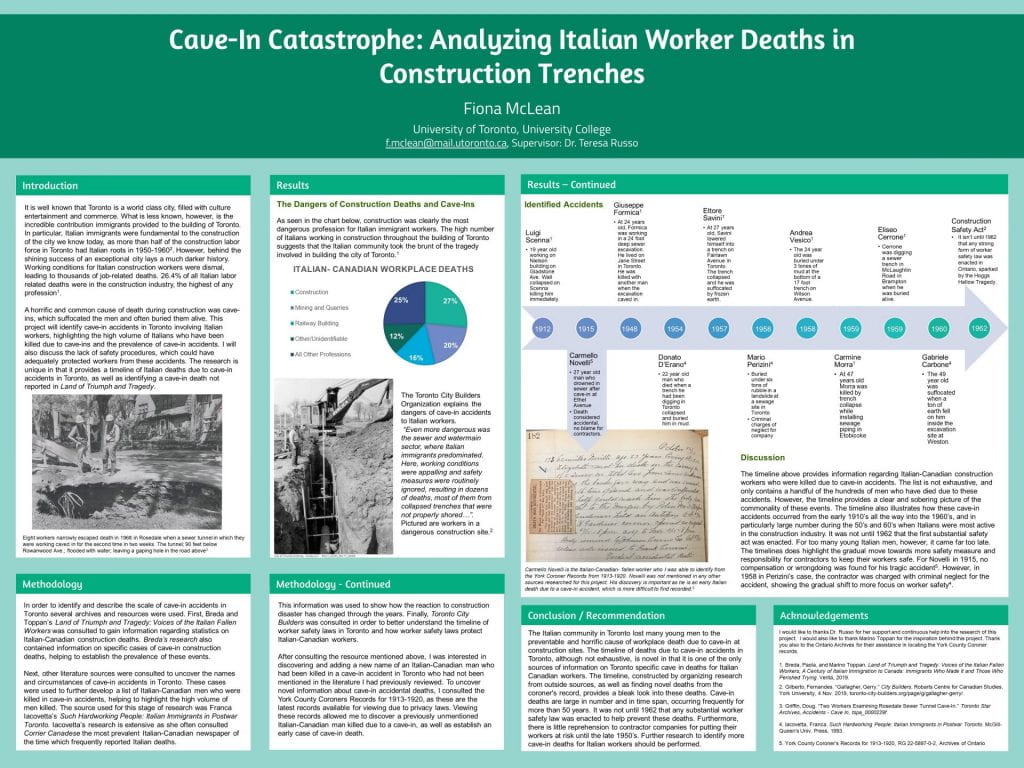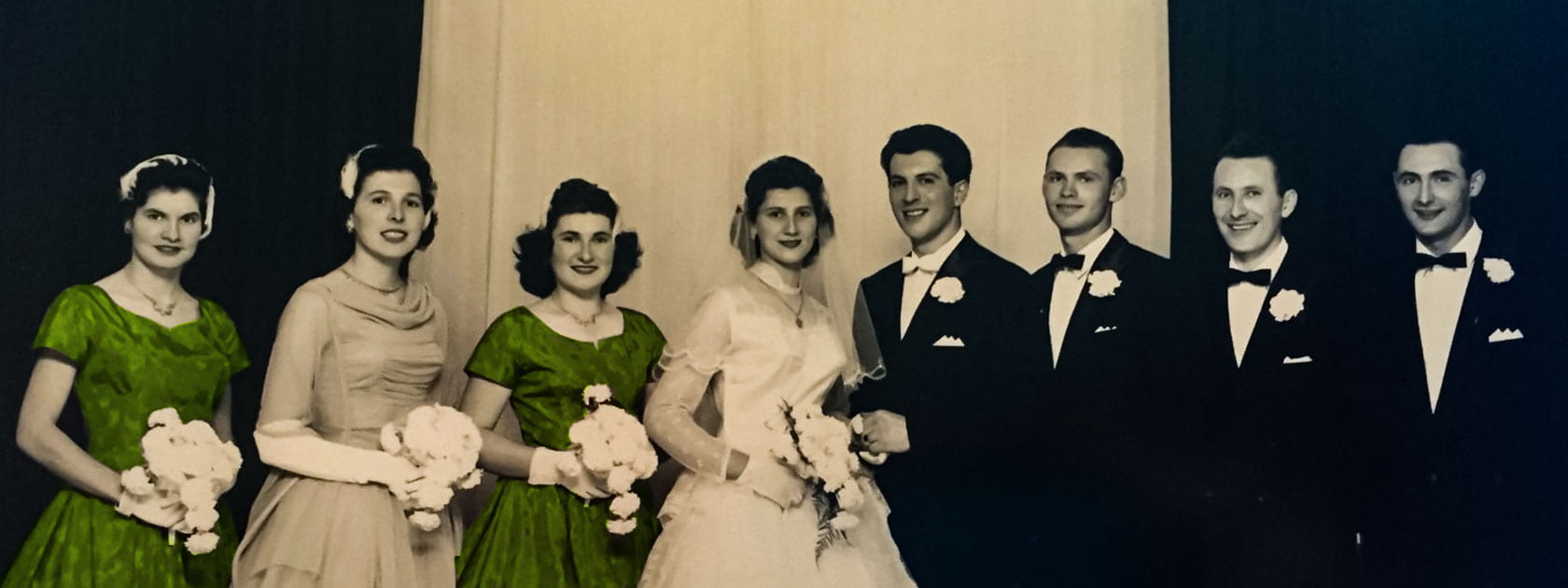
Cave-In Catastrophe and the Discovery of Carmelo Novelli in the Archives
As Torontonians living in a bustling and active city, it is easy to forget that in the past the city we call home was not a city at all. We often take for granted the incredible contributions of the construction workers who built the city we live and work in, many of whom were of Italian background. We forget that not only did these men dedicate their lives’ work to building our city, but many of them also lost their lives in the process.
After a presentation from Marino Toppan, an advocate for Italian-Canadian construction workers rights and recognition, I was inspired to further research Italian-Canadian construction deaths in Toronto. In his presentation Toppan highlighted cave-in accidents, which caused workers to be buried alive, as particularly treacherous accidents that resulted in many deaths. I was compelled to continue research into these cave-in accidents to better understand the breadth and severity of them, as well as how preventable they were. My goal for the project was to identify cave-in accidents in Toronto that involved Italian-Canadian workers and to organize these tragic deaths on a time-line. By doing so, it is clear visually how frequently these accidents occurred in Toronto during the building of the city. I also look to highlight the changes in construction safety laws over time that began protecting Italian-Canadian workers and other minority workers from these accidents. Finally, I sought to contribute something new to the ongoing research by re-discovering an Italian-Canadian cave-in fatality not discussed in any secondary sources considered.
To identify the scale and severity of cave-in accidents, I first consulted Breda and Toppan’s Land of Triumph and Tragedy: Voices of the Italian Fallen Workers. This source provided me with the names and circumstances of many Italian-Canadian construction workers who lost their lives due to cave-in accidents in Toronto. Such Hardworking People: Italian Immigrants in Postwar Toronto by Franca Iacovetta provided additional details about cave-in accidents involving Italian-Canadian men. City Builders, a historical research website sponsored by the Robarts Centre for Canadian Studies provided me with insight into how construction safety laws in Toronto evolved and how a lack of these laws initially led to many avoidable cave-in deaths. Finally, I consulted the York County Coroners’ Records for 1913 to 1920. Due to privacy laws, these are the latest coroner records available for viewing. In these records I was able to identify a previously unmentioned Italian-Canadian death due to cave-in accidents. Carmello Novelli was a 27-year-old man who died in a sewer after a cave-in on Ethel avenue. The discovery of this death is important as the death is recorded in 1915, which is early in the Italian-Canadian construction history of Toronto, highlighting that deaths due to cave-in accidents were prevalent for decades. Secondly, the coroners’ record included a newspaper clipping that states that the death was found to be accidental, and no blame was placed on the contractors. This emphasizes the lack of worker compensation and safety precautions that Italian-Canadians workers were subject to, especially in the early days of construction in Toronto.
Overall, I was able to identify ten Italian-Canadian men who were killed in cave-in accidents in Toronto. These men were Luigi Scanna, Carmello Novelli, Giuseppe Formica, Donato D’Erano, Ettore Savini, Mario Perizini, Andrea Vesico, Carmine Morra, Eliseo Cerrone, and Gabriele Carbone. The information gathered on these men paints a sobering picture. These men ranged in age from nineteen to forty-nine, showing that teenagers and fathers alike were killed due to these work-place accidents. The cave-in accidents occurred from the early 1910’s all the way into the 1960’s and were particularly common during the 50’s and 60’s, when Italians were most active in the construction industry. It was not until 1962 that the first substantial safety act was enacted, even though these deaths were prevalent throughout the construction of Toronto. The information gathered on these men also shows the gradual movement towards more safety measures and responsibility for contractors to protect their workers. Although there was no compensation or wrongdoing found for Novelli’s death in 1915, for Perizini’s case in 1958 the contractor was charged with criminal neglect for the accident. Unfortunately, for too many Italian-Canadian men, the recognition of a need for better safety measures came too late.
The list of ten Italian-Canadian men killed due to cave-in accidents in Toronto, who I have included in my research, is by no means exhaustive. Due to poor record keeping and the anglicization of names, many of these Italian-Canadian cave-in deaths are difficult to find in archives or are lost in history. Further research should be performed to identify more cave-in accidents that involved Italian-Canadians in Toronto. However, the current research is extensive enough to highlight the saddening quantity of Italian-Canadian men who unnecessarily lost their lives due to cave-in accidents as well as to recognize and appreciate the greatest sacrifice they made to help build the city of Toronto.
Fiona McLean,
University College at the University of Toronto, 2020
How to cite this research
McLean, Fiona. “Cave-In Catastrophe and the Discovery of Carmelo Novelli in the Archives.” In Archival Research of Italian-Canadian Immigration and Culture, supvr. Teresa Russo, issue 2: Italian Fallen Workers, University of Guelph, April 2020, Guelph. Italian-Canadian Narratives Showcase Fallen Workers – Italian-Canadian Narratives Showcase (italianheritage.ca)(ICNS), Sandra Parmegiani and Nivashinee Ponambalum.


